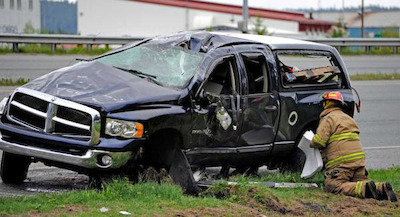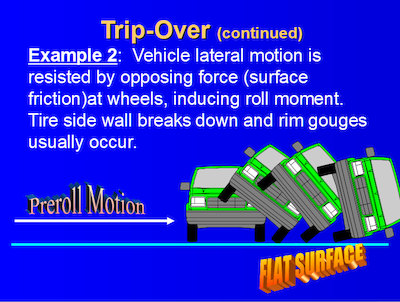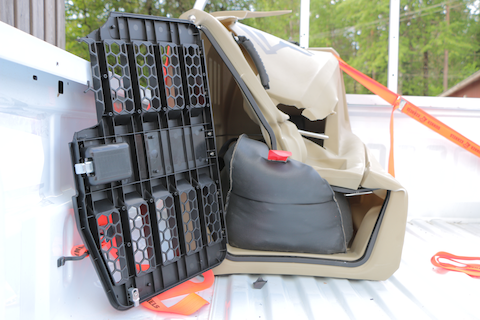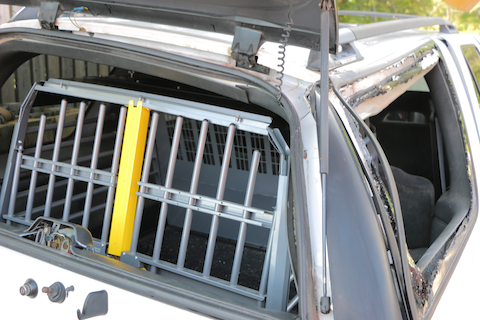Gunner Kennels Video: A Smashing Response
This article is part two of two looking at the claims made in a Gunner Kennels video advertisement. Photo credit JuneauEmpire
In this segment, IMPS looks at how other manufacturers responded to the Gunner Kennels video linked in part I. IMPS learns a bit more about pickup truck beds as well as US NHTSA strength testing of vehicle roofs.

MANUFACTURER RESPONSE
IMPS felt it was important to reach out to the manufacturers of competing crates, as well as Gunner Kennels, to ask some basic questions and see general comments on the Gunner advertisement. Our contact message is annexed at the end of this article in entirety. Only two responded.
PETMATE
IMPS first contacted Petmate.com and was directed to a product manager in their crate line, Courtney Landry. Courtney was on vacation, but did initially respond that she was unaware of the Gunner video and would "respond next week when I'm back in the office." Unfortunately, Courtney never did get back to IMPS, though three follow up attempts were made during September and early October. It is unfortunate when a manufacturer takes the 'better to say nothing' approach, though perhaps Courtney herself would have liked to respond.
What IMPS is able to say is that the RuffMaxx is a low cost polypropylene crate. Polypropylene is a polymer plastic that has a wide number of uses, ranging from clothing to bottle caps to desk chairs. Depending upon the composition, polypropylene may be very flexible or rigid. A familiar example of the rigid variety is the white top of a TicTac container.
The RuffMaxx runs about $80-$100 retail, is an acceptable crate for home use and does meet the ATA standards for air transport. Though the crate has anchor points and Petmate makes passing reference to its use in 'travel', there are far better crates for use in a vehicle. Home and airline use are clearly its forte and it really is odd that Gunner would position a sub $100, limited use crate against their $500 and up product. It is also not surprising that the crate would shatter if a very heavy object is dropped on it and IMPS suspects most pet parents would realize this after inspecting the crate themselves.
GUNNER KENNELS
Gunner Kennels was offered the opportunity to better explain the substance of their "test" by email. IMPS also provided Gunner the questions IMPS asked of the other manufacturers. A representative from Gunner initially replied that their CEO would have to respond, but was out of town that week. IMPS indicated to Gunner that there was still time to respond. Gunner followed up a few days later to ask if IMPS was still interested and an affirmative response was sent. That was on 9/30. In fact, other obligations have delayed the publication of this article until now, so Gunner has had nearly three weeks to respond. Instead, Gunner Kennels has take the same route as Petmate - say nothing.
Though IMPS can possibly understand Petmate's motivations for failing to reply, one has to wonder why Gunner chose not to defend their video advertisement. If Gunner thought the test was of good value to pet parents, shouldn't they be promoting it? For the record, the exact questions IMPS posed to Gunner were:
- Was there a particular safety issue that this test was meant to address?
- MGA, unless otherwise commissioned to do so, only carries out testing as per the direction of their clients. Did Gunner design this test internally? Was MGA or other outside firm asked to design the test and to what specifications?
- What is the predictive value of this test in regards safety for pet parents who are looking for a new crate?
- What are some of the recommended use cases for your crate? Home use? Car travel? Plane transport?
- Gunner often shows crates in the back of open pickup trucks. Is this type of use recommended by Gunner, advised against or just accepted as inevitable use by client?
- Any additional comments you would like to make regarding the video?
IMPS does not think any of these questions are particularly challenging and had hoped the manufacturer would know the answers prior to our inquiry. Pet parents reading this can draw their own conclusions on what weight to give to Gunner's silence. Of note, Gunner also refused multiple inquiries for comment in November 2015 before publication of our own crate study. That study included a significant critique of the Center for Pet Safety crate test methodology. Gunner had been given top marks by CPS for their test results at the MGA Research facility.
RUFF TOUGH
Next, IMPS contacted Doug Sangl of Ruff Tough Kennels. Ruff Tough makes roto molded crates in the $175-$250 price range. One of Ruff Tough's crates was also included in the flawed CPS study and was not well received (point of reference: of the four crates in that study, only the Gunner was given a positive safety recommendation by CPS). At the time IMPS contacted Mr. Sangl, he was not aware of the Gunner video so it was agreed to speak again after he had a chance to view it.
When Doug later contacted IMPS, he indicated he was not happy with the Gunner video and voiced his suspicion that CPS may have had some involvement in the project. Unfortunately, IMPS is unable to confirm or deny such involvement as neither Gunner or CPS will speak with IMPS. However, it is well documented that MGA Research carried out the testing for CPS. That Gunner also chose MGA Research may just be coincidence or could be based upon familiarity. Bottom line, Doug did not think the Gunner video was useful for evaluating the safety of a crate.
Doug felt it could be helpful for IMPS to speak to one of his associates, Rick Noble, and a call was arranged. Rick has over 17 years experience working in the safety side of NASCAR racing. Doug and Rick's paths crossed after Rick was involved in a car accident that also destroyed the travel crate he was using (luckily his dog was not on that trip). Rick reiterated Doug's earlier sentiment about the Gunner video, feeling that it was not really reflective of what would happen in an actual rollover.
IMPS and Rick then discussed rollovers generally, and specifically for pickup trucks. Rick noted that rollovers are almost always sideways and that under stress, "the bed of the pickup tends to twist and the anchor bolts for the tie down straps may break or loosen and detach". Rick also said that in his experience, most hunters do not have toppers on their trucks and it is unfortunately common for the dog crate to be put on the bed and not secured with tie down safety straps.
Wrapping up, Rick informed IMPS that Ruff Tough had recently changed the design of the mounting brackets for tie down straps on their crate. The Ruff Tough team believes the modifications will offer better performance under crash duress. IMPS was impressed by Rick's thorough understanding of vehicle crashes and his NASCAR experience should continue to assist Ruff Tough in improving their crate design.
MIM SAFE
The last manufacturer IMPS contacted was MIM Safe, makers of the Variocage. MIM Safe responded both in writing and later in an early morning phone interview with one of their bio-mechanical engineers, Anders Flogård.
Speaking of the Gunner video, Anders stated MIM's disappointment that a competitor would stage such an event, "We are not sure of what they would like to achieve with this video, where they drop a 630 LBS weight on top of the crates." MIM believes that Gunner Kennels markets their crate for use in an open environment, such as the bed of a pickup truck. However, "Variocage is designed to be used inside a car to secure both pet and human," said Anders. He continued, "If our competitor´s purpose with the test is to simulate a roof crush / rollover situation, we think that they are barking up the wrong tree."
Why does MIM Safe believe dropping a very heavy weight on the top of a crate does not reflect the real world? Primarily because neither do US or European auto regulators. Anders pointed out that for many decades, the United States National Highway Traffic Safety Administration (NHTSA) has promulgated regulations to car manufacturers for testing the strength of a roof and to measure how well the car will absorb the impact forces of a rollover. The principal applicable regulation is FMVSS 216a, a 2009 standards revision.
FMVSS 216a describes the required testing methodology in detail. IMPS has included below a video example of one such test on a small car:
(note that this test was done to the weaker pre 2009 FMVSS 216 standard!)
The newspaper USA Today published a detailed article in 2008 about the pending revision expected to toughen FMVSS 216. In a sidebar, the paper boils the test methodology down nicely to these three points:
- Vehicle is bolted to support system.
- A rigid plate, 2.5 feet by 6 feet, is pressed into the roof on an angle on the driver’s side, at the intersection of the windshield pillar and roof rail.
- Testers measure the force needed to crush the roof 5 inches1. If the amount of force exceeds 1.5 times the vehicle’s unloaded weight2, the vehicle passes. If it’s less than the weight, it fails
The reason the auto roof is tested this way is because it is the corner of the roof that is most subject to the risk of collapse.
In fact, some researchers believe FMVSS 216a does not go far enough
The roof resisting resultant force and the energy associated therewith depict the force for the 10° pitch and 45° roll angle combination to be, in reality, twice smaller than that for the 5° pitch and 25° roll angle combination. This can be interpreted with conviction that occupants will be put at high risk of injuries because the roof, despite meeting the new FMVSS 216 requirement, will collapse catastrophically. As a result, the new regulation will be rendered inadequate unless the platen angle combination of 10° pitch and 45° roll is adopted.
Source: The newly updated FMVSS 216 roof crush modelling and analysis Intl. Journal of Crashworthiness, 1/2011
That sentiment seems to be held more closely in Europe than in the US, perhaps because car manufacturers are more able to influence regulations and the overall safety discussion here in the US.
A more troubling study1 out of the UK and Germany concludes that 86% of rollover events happen after at least one, and often multiple impacts. The same study notes that in non-impact events, 37% of vehicles make 0.5 rotations (ie, end up on their roof) and that the direction of roll is an equal 44% right or left. Only about 2.5% of events were characterized as 'rear over front'. For rollovers preceded by one or more impacts, less than 2% are a flip forward and the number of rolls of 0.25 or 0.5 turns rises to 63% from 47%. (Recall from part 1 that the flip forward type of roll is really the only one that has a chance of a crate impacting flat on its top.)
And what about the dynamics of a rollover? As also mentioned in part 1, and confirmed by the UK/GER data, most events are at some angle to, but principally along the longitudinal axis of the vehicle. Depending on the trip action, the nose or tail may also be elevated.
The NHTSA has a power point presentation2 that can help pet parents better understand both how rollovers take place and what the damage to vehicles looks like (there are quite a few sample images).
Returning to the Gunner video, it is clear that Gunner's assertion that their setup reflects real world rollover risk is pretty much ruled out. MIM Safe, however, believed some additional investigation was justified:
"The first test made was on our competitor’s cage and performed on a 2016 F-150 pick up bed. The pendulum hammer hitting it was a 200mm diameter polyurethane cylinder that was dropped with a center of gravity fall of 254 cm. Weight was 285 kg which then corresponds to the energy level of the competitors “Piano” test. Angle was 45 degrees from horizontal and vertical ... also approximately 30 degrees from sideways as the truck can slide any direction being upside down."
This is pretty simple to visualize - picture a wrecking ball traveling in an arc from a height of 8 feet and aimed to impact near the top corner of the crate. IMPS confirmed that the Gunner crate had been strapped down into the truck bed prior to the release of the wrecking pendulum.

Source: MIM Safe 10/20/2016
Anders portrayed the result as not quite the same as seen previously in the Gunner video. Instead, the Gunner crate is seen to shatter, there is significant intrusion into the crate, injury to a dummy test 'dog, ' and the door to the crate is broken into pieces, detaching from the crate (close observation of Gunner's video shows the same problem with the crate door).
ROTO MOLDING
Pet parents may be surprised by this result but there is a fairly easy explanation. Roto molded containers are unique in that their long surfaces are able to withstand applied forces by flexing. When the force is removed, they return to their design shape and can do this many times. This also makes them a good choice for storing contents that may expand and contract. Rick Noble had earlier mentioned to IMPS that many fuel cells are roto molded.
However, there is also a downside to roto molding. The edges of roto molded containers are much less flexible, and depending on the exact material composition, may even become brittle to impacts. This reduced flexibility is physically necessary for the container structure to maintain its integrity and is a known design trade-off. Any roto molded crate, whether from Gunner, Ruff Tough or some other manufacturer, will be at risk to impact failure at the edges and corners.
So when MIM Safe swung a heavy pendulum at the corner of the Gunner crate, it was hitting it on its weak edge, not a large, flexible plane such as the crate top. From all the earlier points about the dynamics of rollovers, it seems quite important to see what could happen to a crate if it were to impact on one of its eight edges or four corners, the points most at risk in a rollover. The MIM Safe video, following the FMVSS 216a test methodology, does so.
BUT WAIT, THERE’S MORE!
Anders also told IMPS of a second video by MIM Safe. In that run a large, double wide Variocage was put into the cargo area of an old Chevy Blazer SUV. The tailgate was closed and the same weighted pendulum was used to batter the side of the vehicle and at an angle consistent with the FMVSS standard.

Source: MIM Safe 10/20/2016
The result was very different than what happened to the Gunner crate, largely because of the protection afforded to the Variocage by the metal structure of the SUV. This is not to say the Variocage came away unscratched; Anders stated that the top window side corner of the crate was slightly bent but there was no intrusion within the crate - the dummy test dog was untouched. Further, though the SUV door and tailgate were no longer operable, the Variocage was still accessible through its emergency hatch.
This is really quite important. Though it is easy to look at this all very clinically - a pendulum hammer strikes the side of an SUV - the more fitting view point would be: "here is an SUV traveling along at speed that suddenly rolls and strikes a boulder, tree or some other large, dense stationary object." Now imagine if the pet crate had been placed in the back of an open pickup truck bed.
Subsequent to our email exchanges and phone conversation, IMPS was able to view both video clips and they are indeed as was described by Anders. IMPS has been told that MIM Safe plans to release the videos to the public and will forward then links when they are available. IMPS will update this article to reflect that video content, either as an embed or direct link.
Update 10/21: This article has been on hold a few days in hopes of getting the video footage. Late yesterday MIM Safe provided two photos extracted from the videos. MIM expects the video to be available in short order but IMPS is running with what we have today and will update per the above.
Update 10/25: MIM Safe has provided the following direct links to the videos mentioned in this article. Video 1 Video 2. A brief commentary, along with embedded video, was posted as Gunner Kennel Video: Not All Its Cracked Up To Be?
THE FUTURE
One question pet parents may ask is whether what MIM Safe has done with FMVSS 216a can be used in practice to test the strength of all travel crates. IMPS believes that, with some modifications, it could one day serve as the basis for a formal test. However, such a test would only be necessary for travel crates that are designed or recommended for use outside of the cargo area of a car or SUV. Those crates will not have the protection of a vehicle frame to absorb impacts and provide containment and thus must be able to provide those functions on their own.
The choice of the FMVSS 216a methodology as a basis for demonstrating the importance of utilizing the steel structure of a vehicle to protect the crate is not surprising. Prior to the CPS crate tests, MIM Safe made public extremely detailed crash test results of their Variocage product. The testing methodology used was developed by MIM Safe in consultation with SP Structural and Solid Mechanics and based upon the ECE R17 and R44 auto testing standards.
CONCLUSION
What should pet parents take away from all of these videos? IMPS believes the first point, something alluded to in part I, is that marketing departments do not consider safety to be sacred and have no issue with putting out material that appears to show their product as superior to their competitors.
The Gunner crate is, in our opinion, highly vulnerable to critical failure in a rollover. As seen in the MIM Safe video, any impact at significant speed on an edge or corner may cause the crate to explosively shatter. Did the marketers at Gunner purposely ignore these higher probability impact risks to promote the lower probability case that puts their product in the best light and their competitor's the worst? That is a question pet parents must answer for themselves.
The second point is that there can be absolutely no doubt that the safest location to keep a pet travel crate is inside of a vehicle. Though the crate may be shaken, stirred and tossed, it is the metal frame of the vehicle that will first absorb a good portion of the impact energy in a crash or rollover. MIM Safe has demonstrated this point accurately. Likewise, a crate is much more likely to remain confined within the vehicle, even if anchoring straps are broken.
Do you only drive a pickup truck?
For pickup truck pet parents, there is no simple answer. IMPS suspects that many dogs conveyed in a pickup require a crate too large to store inside of a crew cab, so it must be placed in the bed of the truck. As Rick Noble of Ruff Tough pointed out, tie down straps are important, but all bets are off if and when the truck bed begins to flex. The use of a topper, though they are often weak, can provide some degree of protection from the first inpact after a rollover. In an ideal world, no pet should be crated in the bed of a pickup truck - there are just too many things that can go very wrong. Even presupposing that a crate could be manufactured which remains intact after flying off the back of the truck, would the dog inside survive?
IMPS has mentioned a few times that the door on the Gunner crate detached explosively in both their own and the MIM Safe videos. Just for a moment, ignore all other consideration of the post crash condition of the crate. A failure of the door can, and often does, lead to tragedy. A crate door, like the sides, must contain and confine the pet to the interior of the crate. Without the door, the pet can be ejected out of the crate, similar to what happens to pet parents who do not wear seat belts and are ejected out a car window. Even omitting that tragic worst case, the dog, probably injured, is likely to run away. As a result, the dog may be hit by a moving vehicle or it can be lost, never to return.
The three best selling vehicles in the United States are all pickup trucks. If there is a final caution to pet parents, know that all pet crates are highly vulnerable in a rollover when stored in the bed of a pickup truck. If you have no other choice, please drive extra cautiously and consider adding a topper.
1. VEHICLE ROLLOVER – AN IMPORTANT ELEMENT IN MULTIPLE IMPACT CRASHES (nhtsa.dot.gov) pdf
2. Collection of NASS CDS Data Relating to Rollover (nhtsa.dot.gov) ppt
IMPS Initial Email Contact Questions
Hi XXXX -
I am a pet safety blogger. Last year I did an extensive analysis of Center for Pet Safety "testing" of a few dog crates. I then moved on to other topics.
A few weeks ago for the heck of it I googled around a bit on some of those names to see if there was anything new to write about. I came across this Youtube advertisment/test commissioned by Gunner that includes your product.
https://www.youtube.com/watch?v=JdKf-4h7EAA
I plan to have a relatively short piece about this test in the coming weeks and wonder if you would be willing to answer come questions (on the record)?
1- Were you aware that Gunner had plans to include your crate in their test?
2- Do you believe the Gunner test has any predictive value in regards the safety of any of the crates tested?
3- What are some of the recommended use cases for your crate? Home use? Car travel? Plane transport?
4- Gunner often shows their crates in the back of open bed pickup trucks. Is this something RoughTough would feel comfortable with?
5- Any general thoughts on the Gunner video?Thanks again for your thoughts. Again, feel free to reply to any of those.


